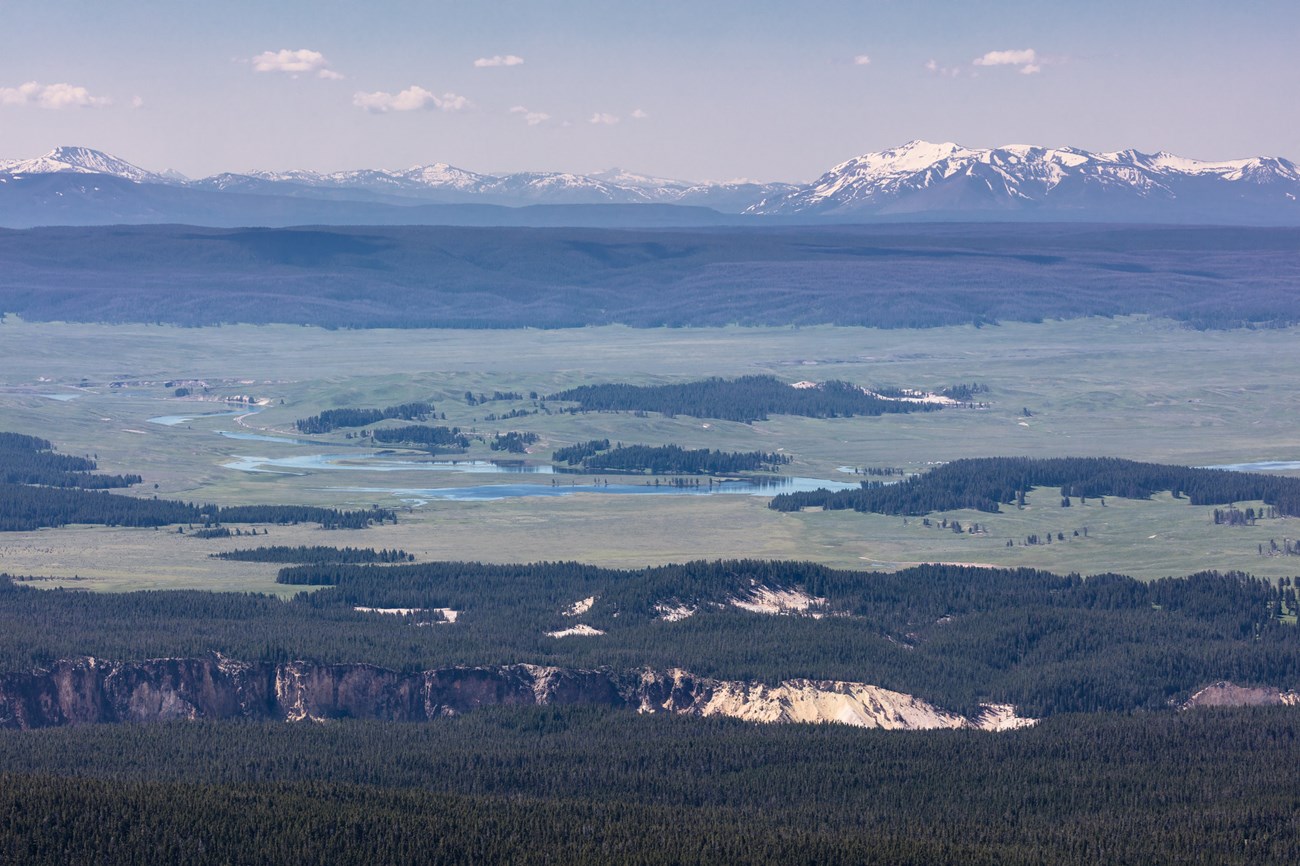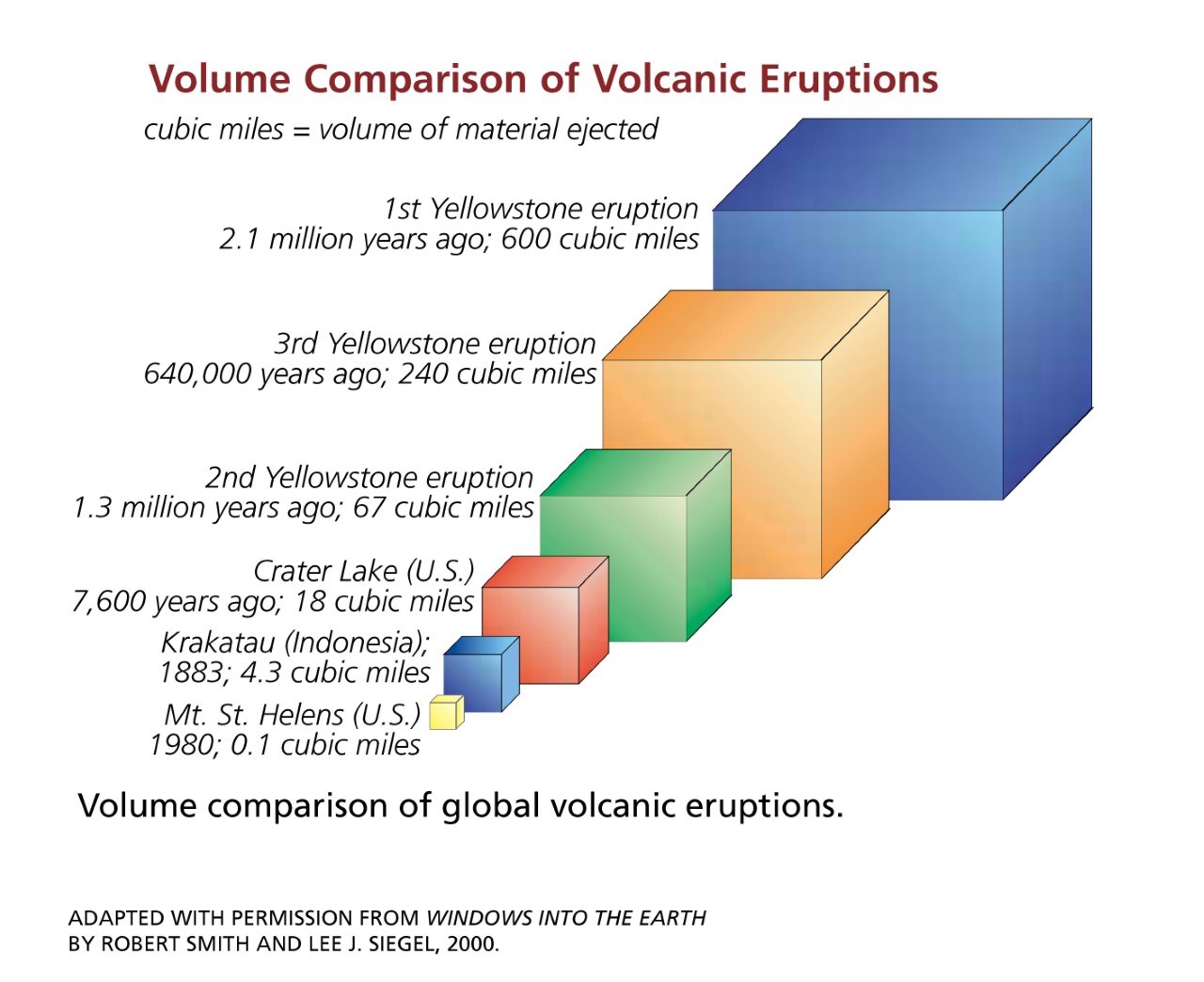Part of a series of articles titled Volcano Types.
Previous: Nonexplosive Calderas
Next: Volcanic Domes
Article

NPS photo by Jacob Frank, July 1, 2017.
Supervolcanoes are volcanic centers that have experienced the eruptions ranked at level 8 on the Volcanic Explosivity Index (VEI). The VEI is a scale that describes the size of volcanic eruptions based on magnitude and intensity. It is a numerical scale (from 0 to 8) on a logarithmic basis that is generally analogous to earthquake magnitude scales.
VEI 8 eruptions:
Have ejected volumes of lava (as pyroclastic fragments and volcanic ash) that are greater than 200 cubic miles (1,000 cubic km).
Produce eruption columns that reach more than 16 miles (25 km) or approximately 85,000 ft into the stratosphere. Winds can carry ash from these eruptions across the planet. Ash-fall deposits from Lava Creek eruption from Yellowstone 640,000 years ago can be found as far away as the Mississippi River in Louisiana.
Are classified as Ultra-Plinian in the traditional classification description (eruption style) based on characteristics of classic eruptions of well-known volcanoes. These eruptions are larger than the eruption of Vesuvius in 79 CE that was witnessed by Pliny the Elder.
Are described qualitatively as Apocalyptic. Each value on the VEI has a qualitative description ranging from Effusive (VEI 0) to Apocalyptic (VEI 8).
The volcanic centers (known as resurgent calderas) that have produced VEI 8 eruptions are truly massive in scale, although they do not build imposing volcanic edifices like shield volcanos. For example, the Yellowstone Caldera is approximately 53 by 28 mi (85 by 45 km) in diameter but its walls only rise approximately 1,600 ft (500 m).
VEI 8 eruptions emit so much molten material that the roof of the magma chamber caves in forming the cauldron-like collapse structures known as calderas. The overall landform of a resurgent caldera is a a broad volcanic plateau ringed by low cliffs that mark the location of caldera walls, and contain an uplifted area (resurgent dome) in the center caused by subterrain magma movements.
Resurgent caldera systems experience many eruptions of varying intensity and magnitude before and after the caldera-forming ones. Both Yellowstone and the Valles Caldera, the two resurgent calderas in national park sites, erupted a variety of lava flows, lava domes, and/or pyroclastics in pre-caldera and/or post-caldera activity.
Although the term “supervolcano” is established in the popular lexicon, its scientific use is less so. Some volcanologists, including the Scientist-in-Charge of the Yellowstone Volcano Observatory, Mike Poland, do not like the term. These scientists prefer to describe VEI 8 eruptions as “super eruptions” versus calling the volcanic centers themselves “super." Volcanic centers that have VEI 8 eruptions also experience eruptions of small magnitudes, both before and after the climatic caldera-forming ones.
VEI 8 eruptions (e.g., super eruptions) are rare. An inverse relationship exists between the size of an eruption and how frequently eruptions of that size occurs. Worldwide, approximately 40-50 volcanoes are erupting at any given time, and 1,350 volcanoes have erupted during the Holocene. But no VEI 8 eruptions have occurred in the Holocene, with the most recent super eruption (VEI 8) occurring at the Taupo Caldera in New Zealand approximately 27,000 years ago.
Yellowstone has experienced two VEI 8 super eruptions.
Island Park Caldera (also known as the Huckleberry Ridge Tuff Caldera) formed 2.1 million years ago when a total volume of 590 cubic miles (2,450 cubic km) was erupted.
Third Yellowstone Caldera formed 640,000 years ago when a total erupted volume of 240 cubic mi (1,000 cubic km) was erupted.

NPS image https://www.nps.gov/yell/learn/nature/volcano.htm.
Part of a series of articles titled Volcano Types.
Previous: Nonexplosive Calderas
Next: Volcanic Domes
Last updated: November 18, 2022